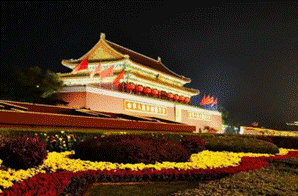
As October 1st approaches, China brims with a festive atmosphere—red flags flutter on streets, lanterns adorn squares, and families embrace a well-deserved break. This important occasion, known as the National Day Holiday, is far more than just a week of leisure; it carries profound historical weight and reflects the country’s past, present, and people’s hopes. Let’s explore the story behind this beloved holiday.
1. The Origin: A Milestone Marking a New Era
The National Day Holiday traces its roots to a pivotal moment in China’s history: October 1st, 1949. On that day, at Tiananmen Square in Beijing, the founding ceremony of the People’s Republic of China (PRC) was held. Mao Zedong, the great leader, solemnly declared the formal establishment of the PRC—an event that ended decades of war and instability, and opened a new chapter for the Chinese nation.
To commemorate this historic milestone, the Central People’s Government officially designated October 1st as “National Day” in December 1949. Initially a one-day public holiday, it later evolved into a 7-day “Golden Week” (combining the 1st with weekends and adjacent workdays) to allow people more time to celebrate and relax. This extended holiday, launched in 1999, has since become a signature of National Day celebrations.
2. Historical Origins: Beyond 1949
While 1949 is the “birth year” of National Day, its spiritual origin lies in the Chinese people’s century-long struggle for national independence and people’s liberation. For over 100 years before 1949, China endured foreign aggression and domestic turmoil. Countless revolutionaries, soldiers, and ordinary citizens fought bravely to defend their homeland and pursue a better life.
National Day is thus not just a celebration of a single day in 1949, but a tribute to that arduous struggle. It honors the sacrifices of those who laid down their lives for the country, and symbolizes the Chinese nation’s rise from weakness to strength, from division to unity.
3. The Significance: More Than a Holiday
National Day is much more than a break from work or school—it is a “spiritual anchor” for the Chinese people, carrying three core meanings:
• A symbol of national unity: On this day, people from all ethnic groups, regions, and walks of life gather (in person or online) to celebrate. It reminds everyone that China is a big family, and unity is the foundation of the country’s development.
• A reminder of historical responsibility: National Day encourages people to reflect on the country’s journey—how it overcame hardships to achieve today’s prosperity. It inspires a sense of duty: to cherish the peaceful life and contribute to the nation’s future.
• A showcase of national strength: Every year, National Day is accompanied by grand activities (such as the military parade held every 10 years, or themed exhibitions). These events display China’s achievements in economy, technology, military, and people’s well-being, boosting national pride.
4. Modern Celebrations: How People Celebrate Today
Over the years, National Day celebrations have blended tradition and modernity, reflecting people’s diverse lifestyles. Here are the most common ways to celebrate:
• Travel and explore: The 7-day Golden Week is one of China’s peak travel seasons. Families and friends visit scenic spots (from the Great Wall to tropical islands), historical sites (like the Forbidden City), or even neighboring countries. It’s a chance to relax and experience different cultures.
• Family gatherings: For those who prefer a quiet holiday, staying home and reuniting with family is a popular choice. They cook traditional dishes, watch National Day-themed TV programs (such as gala shows), or take short trips to local parks.
• Festive decorations: Streets, communities, and businesses are decorated with red flags, flower beds, and lanterns. Many people hang small flags at home or on their cars to express their love for the country. In some cities, night parades with lights and performances add to the joy.
• Cultural and patriotic activities: Museums and memorial halls often hold special exhibitions about China’s history and development. Schools and communities organize flag-raising ceremonies, singing contests (featuring patriotic songs), or volunteer activities (such as helping clean scenic spots), allowing people—especially young people—to connect with the holiday’s spirit.
Wrapping Up
National Day is a bridge connecting China’s past, present, and future. It reminds us of where we came from, makes us proud of what we have achieved, and inspires us to strive for a better tomorrow. Whether you travel far, stay with family, or join in festive activities, the core of the holiday is the same: love for the country, and gratitude for the peaceful and prosperous life we enjoy.
Happy National Day to all! May the country thrive, and may people live in happiness!